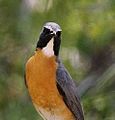White-throated robin
| White-throated robin | |
|---|---|

| |
| female and male | |
| Scientific classification | |
| Domain: | Eukaryota |
| Kingdom: | Animalia |
| Phylum: | Chordata |
| Class: | Aves |
| Order: | Passeriformes |
| Family: | Muscicapidae |
| Genus: | Irania de Filippi, 1863 |
| Species: | I. gutturalis
|
| Binomial name | |
| Irania gutturalis (Guérin-Méneville, 1843)
| |
| Synonyms | |
| |
The white-throated robin (Irania gutturalis), or irania, is a small, sexually dimorphic, migratory passerine bird.[2] The vernacular and genus name Irania alludes to Iran, its type locality, while the specific name gutturalis is Medieval Latin for "of the throat".[3] It breeds in western Asia and overwinters in East Africa.
Relationships
[edit]It was formerly classed as a member of the thrush family, Turdidae, but is now more generally considered to be an Old World flycatcher, family Muscicapidae. It, and similar passerine species, are often called chats.
Description
[edit]This species is larger than the European robin, having a length of 16 centimetres (6.3 in) and a wingspan of 28 centimetres (11 in).[4] The breeding male has lead-grey upperparts, a black face with a white throat and supercilium, and orange underparts. The tail is black, as is the strong bill. Females are plainer, mainly grey apart from a black tail, hints of orange on the flanks, and some white throat streaks.
Song
[edit]The male's song is a fast twittering, given from a bush or in flight. The call of this species is a chis-it double note, like that of the pied wagtail.
Food
[edit]Though it is insectivorous, it will also eat fruit during autumn.[4]
Range and habitat
[edit]It is a migratory species, breeding from Turkey to Afghanistan in western Asia, and wintering in East Africa. In East Africa they are found in closed thicket in dry country, typically Acacia-Commiphora woodland on the dry central plateau. Small numbers reach the Usangu Plains of Ruaha National Park in Tanzania, which is normally their southern limit. In dry years however, some may move still further south, and reach moister uplands at 1,600 metres.[5] It is also a very rare vagrant to Europe.
Breeding
[edit]The white-throated robin's breeding habitat is dry rocky slopes with some bushes, often at some altitude. It nests in a shrub, laying 4-5 eggs.
Media gallery
[edit]-
Video of foraging male in Saudi Arabia, 1993
-
Male, showing white throat and rufous breast
-
Irania gutturalis - MHNT

References
[edit]- ^ BirdLife International (2016). "Irania gutturalis". IUCN Red List of Threatened Species. 2016: e.T22709758A87893515. doi:10.2305/IUCN.UK.2016-3.RLTS.T22709758A87893515.en. Retrieved 12 November 2021.
- ^ ITIS.gov
- ^ Jobling, James A. (2010). The Helm Dictionary of Scientific Bird Names. London, United Kingdom: Christopher Helm. pp. 182, 207. ISBN 978-1-4081-2501-4.
- ^ a b BirdFacts British Trust for Ornithology
- ^ Tanzania Bird Atlas, preliminary data
External links
[edit]- Irania gutturalis in Field Guide: Birds of the World on Flickr
- "Irania gutturalis". Avibase.
- Photos at BirdGuides.com
- Photos and videos on Birds of the world



